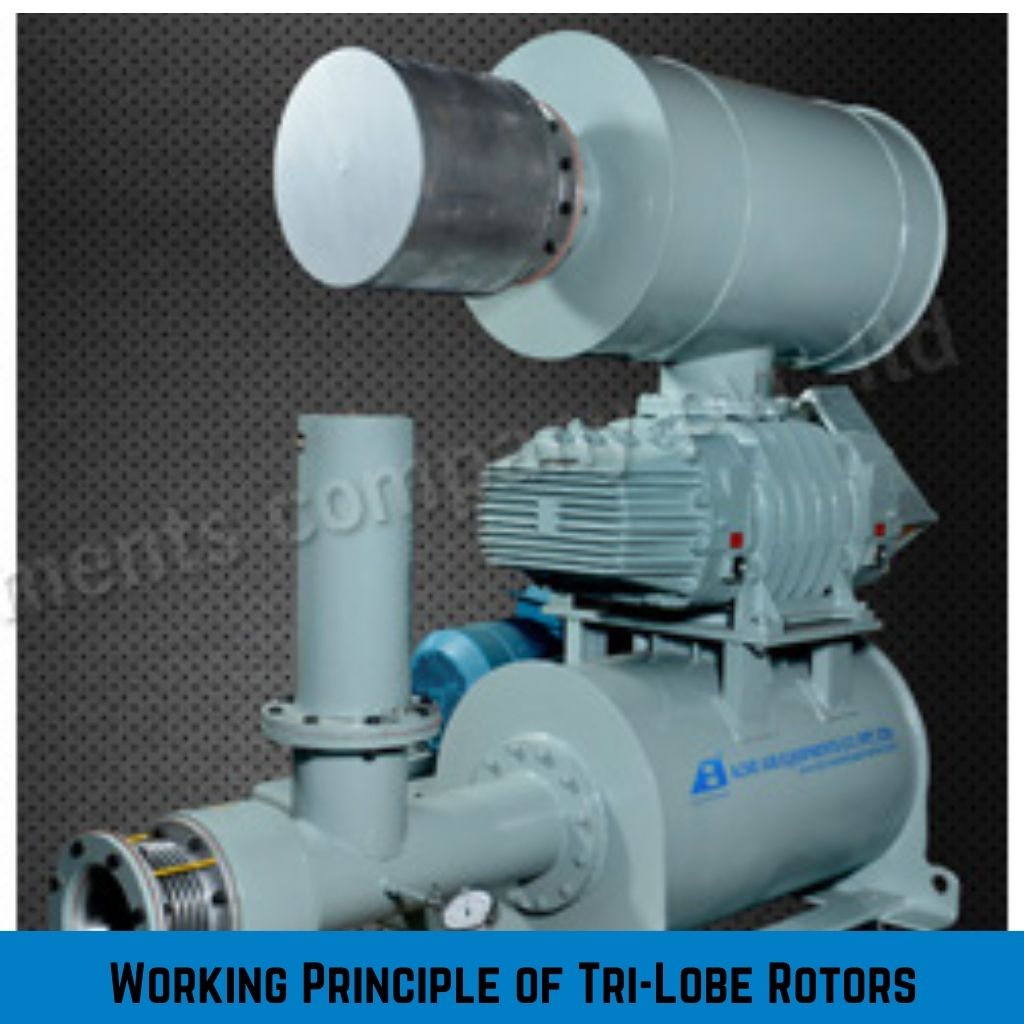Table of Contents
A Tri Lobe Roots Blower is a type of positive displacement blower that operates on the principle of mechanical compression and air movement. It is commonly used for moving air or gases in various industrial applications. The Tri Lobe Roots Blower is known for its precision, reliability, and high-performance capabilities, especially in systems that require consistent airflow and pressure.
This article focuses on the working principle of the Tri Lobe Roots Blower, explaining how it operates, its components, and the step-by-step processes involved in generating airflow.
What is a Tri Lobe Roots Blower?
A Roots Blower is a type of rotary positive displacement blower that utilizes rotating lobes to move air. In the case of a Tri Lobe design, each rotor has three lobes, which results in a smoother operation compared to traditional two-lobe rotors. This type of blower is used in applications that require high efficiency and consistent airflow, such as aeration systems, pneumatic conveying, and other industrial systems.
The Tri Lobe Roots Blower consists of:
- Two or more rotors: The rotors have three lobes each and rotate in opposite directions.
- Casing: The housing where the rotors operate and where air is trapped and moved.
- Inlet and Outlet Ports: These are the entry and exit points for air or gas.
- Drive Mechanism: Typically powered by an electric motor or engine that drives the rotors.
The key aspect of this blower’s design is that the rotors do not touch each other. This is critical for ensuring smooth operation and minimizing wear.
How Does the Tri Lobe Roots Blower Work?
The operation of a Tri Lobe Roots Blower can be broken down into a few distinct stages:
Rotor Movement
The Tri Lobe Roots Blower consists of two rotors, each with three lobes. These rotors are housed in a casing and rotate in opposite directions (counter-rotating). The rotation is powered by an external drive mechanism, typically an electric motor.
As the rotors rotate, their three lobes mesh and move in close proximity but do not touch. This intermeshing of the lobes creates separate pockets of air between them, which are progressively moved from the inlet to the outlet. The precise intermeshing of the lobes ensures that air is moved without any significant leakage, which maximizes the efficiency of the blower.
The opposite rotation of the two rotors ensures that one rotor pushes air into the blower while the other creates space for the air to enter, creating a continuous airflow.

Suction Phase (Intake)
In the initial stage of operation, as the rotors begin to rotate, the space between the lobes and the casing expands, which creates a vacuum that draws air into the blower. The air enters through the inlet port, and as the rotors continue to rotate, the air is trapped between the lobes.
Since the lobes are designed with precision, the air is trapped in discrete pockets that move progressively toward the discharge side of the blower. As the rotors rotate, more air is continuously drawn into the system. The size of the air pocket increases as the lobes rotate, allowing the blower to handle varying amounts of air.
Compression Phase
Once the air is trapped between the rotating lobes, the rotors continue to move, pushing the trapped air along the rotor cavity toward the discharge side. As the air moves, the space between the lobes begins to decrease, causing the air to compress.
This stage of operation is where the positive displacement nature of the blower comes into play: The fixed volume of air within the pockets of the rotor is mechanically pushed through the system. The rotational speed and the number of lobes play a key role in determining the airflow rate and pressure the blower can generate. The three-lobe rotor design is particularly beneficial in this phase because it allows the blower to operate more smoothly and with fewer pulsations than other blower types.
Discharge Phase (Exhaust)
The compressed air reaches the outlet port of the blower, where it is released into the system. At this stage, the air has been compressed by the action of the rotors and is expelled under higher pressure than it was when it entered.
Unlike many other types of blowers, Tri Lobe Roots Blowers are designed to expel air with minimal pulsation, which is crucial for ensuring a continuous flow of air or gas. The smooth operation of the Tri Lobe rotors helps to maintain a consistent flow rate and pressure even under varying load conditions.
Continuous Cycle
The Tri Lobe Roots Blower operates in a continuous cycle: As the rotors keep rotating, air is continuously drawn in through the inlet, compressed, and expelled through the outlet. This constant cycle allows for steady and reliable airflow, making the Tri Lobe Roots Blower an efficient solution for industrial applications that require constant and controlled air or gas movement.
Key Features of the Tri Lobe Roots Blower Design
- Three-Lobe Rotor Design: The Tri Lobe design allows for smoother and more stable operation compared to two-lobe models. This results in fewer pulsations and more consistent airflow.
- Minimal Contact Between Rotors: The rotors in a Tri Lobe Roots Blower do not touch each other, which reduces friction, wear, and tear, extending the lifespan of the blower and maintaining performance.
- High Efficiency: The design of the Tri Lobe Roots Blower minimizes energy loss and ensures high volumetric efficiency. By reducing leakage and friction, the blower operates with greater energy efficiency compared to other types of blowers.
- High Capacity: The Tri Lobe design allows the blower to handle a larger volume of air than traditional blowers, making it suitable for both low- and high-capacity applications.
- Versatility: Tri Lobe Roots Blowers are capable of handling air, gas, or vapor and are adaptable to various applications across industries, including pneumatic conveying, wastewater treatment, and vacuum systems.
Conclusion
The working principle of the Tri Lobe Roots Blower is based on a well-defined sequence of mechanical actions involving the rotation of the three-lobed rotors, creating pockets of air, compressing them, and displacing them through the outlet port. This mechanism results in smooth and continuous airflow, making the Tri Lobe Roots Blower an ideal choice for applications that require consistent and reliable air or gas movement.
With its precise rotor movement, efficient design, and minimal pulsation, the Tri Lobe Roots Blower stands out as an essential component in various industries where air handling is critical. By understanding its working principle, engineers and operators can maximize its performance, ensuring optimal operation in systems that demand high efficiency and long-lasting reliability.
About Author

CEO
Mr. Vishwesh Pardeshi is the CEO of Acme Air Equipments Company Pvt. Ltd., an industrial and engineering goods manufacturing company based in Ahmedabad, Gujarat (India). He has taken over the responsibility from founding Partners and Directors of the Company, and is now leading a talented group of professionals since 2020 by bringing in vast industrial and management expertise. By qualification, he holds a Bachelor Degree in Mechanical Engineering and also holds a MBA degree from reputed institutes. Under his leadership, the Company has successfully executed prestigious projects by delivering high quality and world class products from a state of the art manufacturing facility which combines CNC-enabled precision manufacturing and strong after sales support. In line with the Vision, Mission and Core Values of the Organization, Mr. Vishwesh Pardeshi continues to drive Quality, Reliability and Global Expansion at Acme Air Equipments Co. Pvt. Ltd.









